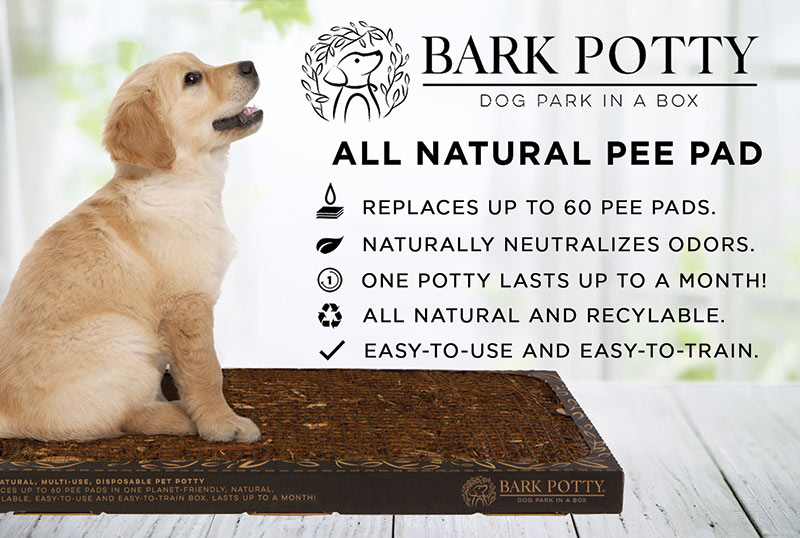6 Week Old Puppy Care: Essential Training & Supplies
The day your puppy comes home is super-duper important. To a large extent, the success of your relationship depends on how well you teach him the rules of domestic living. Your help and guidance in the next few weeks can set you both up for success and create that amazing dog-owner bond we’re all looking for when we decide to get a puppy.
Research breeds before you buy.
While bringing a puppy into your house isn’t rocket science, it isn’t a piece of cake, either. If you assume that it is, you could end up with buyer’s remorse. One of the easiest ways you can stumble is just assuming that “a dog is a dog is a dog.”
It is crucial that you study up on any potential breeds you may be interested in to see how compatible they are with your life and environment. While some of these metrics may look like no-brainers - a mastiff wouldn’t work in a tiny apartment - others may not be obvious.
For instance, dogs that were bred to be workers are usually high-energy dogs will require plenty of exercise to be happy. If you’re not willing to meet their needs, they may exert their energy by ripping up your furniture or garden.
Also, just because a dog is small doesn’t mean that he’ll be the lapdog you want him to be. Some breeds thrive on independence, which means they may prefer to carve out more “alone time” that you may want if you’re looking for a constant companion.
Perhaps most critically, some breeds are simply tougher to train than others. While these dogs can undoubtedly turn into warm, loving pets if you put forth the proper amount of effort, doing so will require significantly more patience than you may have time to give. If you can’t give the effort required, life with Fido can be miserable.
Get the right supplies for a 6-week old puppy.
Before you bring your pup home, you’ll need some supplies. Here’s a quick rundown: a crate, food and water bowls, cleaning supplies, high-quality food, leash, collar, doggy shampoo, a few fun toys, and some poop bags.
Create a comfortable environment
Your new puppy is going to need some time to acclimate himself to his surroundings, especially since he’s still trying to get a firm grasp of this whole “life” thing. Because of this, you want to create an environment where he can feel safe and comfortable while he figures things out.
To accomplish this, make sure you prepare a safe spot in a designated area in your home, guarded by a boundary. Once he’s at home, work with him to establish this spot as his fortress of solitude, where he can chill if things get too overwhelming. As he gets more comfy, you can expand this space.
At the outset, it’s also smart to keep him out of reach of things that could cause him harm. This includes items that, if you’ve owned pets before, you may not think of as a huge deal, such as stairs and chairs. Remember, these little guys have delicate frames; if they try to do something their body isn’t ready to do, they could incur some damage.
Ideally, you’ll want to make sure your created space contains easy access to a garden, backyard, patio, or whatever outside spot you’ve designated as his potty zone. When you potty train with your pup, it’s wise to return him to his safe zone after he does his business. This way, he can make the connection that it’s safe and appropriate to go outdoors when nature calls.
It takes a village to raise a pup - if you have a village
If you’re part of a family that is bringing home a new pup, it is important that you and your brood work together as a team to help train your puppy right. This is particularly true if you have little kids in the house. After all, they may be so super excited about the adorable little pup in their home, they may not want to leave the poor thing alone.
If you don’t act as a cohesive unit, you run the risk of confusing the dog, because he won’t have a concrete bead on what he should be doing. This lack of consistency could lead to him partaking in the very behavior that your training is supposed to thwart. And let’s face it - your kids probably won’t be the ones cleaning up his indoor accidents.
What about food? How often should you feed a 6-week old puppy?
Every puppy and every breed is different, so it's a good idea to talk to your vet about your puppy's nutrition before you settle on a good dog food and a feeding routine.
related resources
In general, though, 6-week old puppies are just being weaned from their mother's milk, and you'll be introducing them to solid food. You'll want to pick a high-quality food formulated specifically for puppies, which is important because puppies typically need more calories per pound than adults do (they're growing after all). The main thing to look for in a good food is that the primary ingredient is meat (not corn) and that there are plenty of good veggies.
Again, talk to your vet, but here's a quick guide to get you acclimated:
Start learning some basic dog skills.
It’s important to supervise your puppy, especially in the first few days of his arrival. Welcome him on a day when your schedule isn’t too hectic, so you can be around for longer periods of time. If you hold a 9-5 job, the weekend is usually the best time to bring him home for the first time. That way, you’ve got plenty of time to spend with him and can help him learn some of the basic rules of the house.
In general, the very most important skills for your puppy to learn are (1) potty training and (2) staying in his crate. When you start to tackle basic dog skills, it’s good to remember that most puppies respond best to play training. Even then, it’s best to take a gradual, patient approach, and it certainly doesn’t hurt to sign up for some good puppy training classes.
The main reason why patience is so important is that your little fur baby is just that - a baby. Just like a child, he’s going to have a short attention span, and you must meet him at this level. It’s recommended that you dole out training of any kind in short, small bursts so he has less of a chance at failing.
Here’s a quick video that can help you crate train your pup:
Potty train your puppy (the right way).
You don't want your puppy to learn to eliminate wherever he pleases. After an hour in his crate, release him and run him over to his toilet area. Tell him to eliminate and give him a few minutes to do so. If he does, praise him enthusiastically and give him a treat and then play with him for a while. Puppies are easy to train if you stick to a routine and have a good reward system.
Here’s a good video demonstrating proper potty training:
Start learning socialization skills early.
Next to basic home skills, your puppy needs to learn to socialize with a variety of people and a variety of animals. In the first six weeks of his life, he is still learning to survive, so things can be a bit scary.
It’s also a bit traumatizing. Remember, while you are welcoming the little guy with open arms and all kinds of excitement, this is his first time leaving the comfort and serenity of his mother and his siblings. He’s basically coming to you a stranger in a strange land.
As a rule of thumb, he should be meet a lot of people before he reaches 3 months old. Invite your friends to your home. Throw puppy parties where other people can hand feed and train him for you. By exposing him to different types of people, he can learn all kinds of useful skills, including how well-behaved dogs interact with each other and bite inhibition.
However, his socialization should not be limited to familiar faces. Take him on regular walks to accustom him to strangers. Well-socialized dogs grow up to be wonderful companions, while the antisocial ones can not only cause headaches to owners, but can even be dangerous.
Keep in mind that there are some breeds whose idea of socialization chiefly involves being loyal and protective of you and your family. For instance, if you bring a Cane Corso into the fold, expect him to be lovely toward you and aloof toward strangers after training. This behavior is fine in these cases, as it is quite literally the nature of the beast.
Help your puppy learn to be home alone.
Inevitably, Fido will have to be left at home alone. You want him to learn to eliminate at the right place, not to chew on stuff, and to entertain himself while you’re gone.
To do this, set up a long-term confinement area and equip it with a comfortable bed, a bowl of fresh water, a doggy toilet, and plenty of chew toys. Put him there when you leave for extended periods of time. Unsupervised and untrained puppies who are given a free rein of their surroundings become anxious and hyperactive. Confinement prompts him to focus on his chew toys only.
If you’re keeping your pup indoors for an extended period of time, it’s important that you train him to use a doggy toilet or a potty pad while you’re away. This is critical because if your pup is trained to go outside, he may not know what to do if you have his normal bathroom blocked. It’s an extra step in the training process, but it’s worth doing.
And if your pup has access to the outdoors when you’re home, that doesn’t necessarily mean he should access when you’re not. A pup left alone outdoors may become anxious and hyper because the space is much larger than his safe area. He may react to this “freedom” by digging up lawns, burying toys, and causing general mayhem.
If your dog is already showing signs of separation anxiety when you’re not around, he may react to you not being there by whimpering, barking, and howling. This noise could escalate into something cacophonous to your neighbor’s ear, which in turn could impede neighborly relations. And you don’t want to be thought of as “the neighbor whose dog’s won’t shut up.”
If your puppy suffers from separation anxiety (pretty common with rescued dogs), here’s a good resource that might help:
Help him learn to love his own company.
Dogs are highly social animals. Before attempting to leave a puppy for long periods, teach him to enjoy his own company without being stressed or anxious.
Start by teaching him to settle down with a chew toy when you’re in the room. Make quiet moments part of his routine. For example, while you are watching television, put him on a leash or in his crate and encourage him to settle down beside you for longer and longer periods. Then, release him for short play training breaks during commercial.
The first few weeks of your puppy's arrival can be hectic and challenging, and being prepared is super important. Without some care and training, your pup can develop destructive habits that are much more difficult to break down the road.
Ask a Vet Question
Here are a few more good resources to help you prepare to bring your puppy home!
http://www.cesarsway.com/dog-training/puppy/starting-your-puppy-off-right
http://www.perfectpaws.com/htrp.html#.Vb3rdG6qpBc
http://dogtime.com/puppy-training-home-alone-dunbar.html
https://www.dummies.com/how-to/content/leaving-your-puppy-home-alone.html
http://www.tarynblyth.co.za/articles/puppyhomealone/



